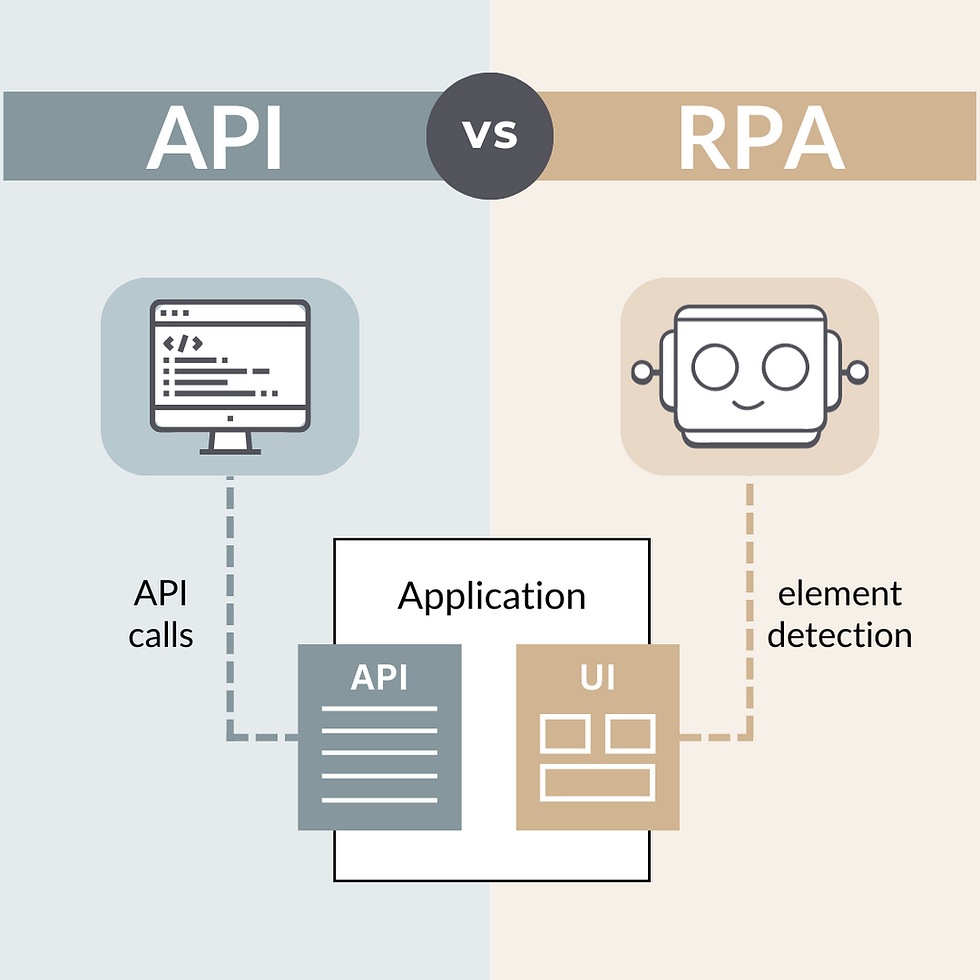API or RPA - Which Solution is Better For Small Businesses?
- Courtney McKay

- May 23, 2023
- 3 min read
Updated: Sep 13, 2023

Automation involves interacting with one or more applications to streamline processes. API and RPA are two common technologies used for automating these interactions. As a small business owner, you may be familiar with API if you've used an integration tool like Zapier or Make. These tools allow users to easily connect to the APIs of widely used applications. RPA is not as well-known in the small business space, but it offers a better approach for automation in certain cases. In this blog post, I'll describe these two technologies in detail, highlight their differences, and identify situations where one may be more suitable for automation than the other.
API vs. RPA - Understanding the Difference
The primary distinction between API and RPA is how they interact with applications. In the diagram above, you'll notice a single application with two separate interfaces. On the left is the Application Programming Interface (API), a set of rules and protocols that facilitate communication between applications. On the right is the User Interface (UI), the visual and interactive part of the application that allows users to interact with it.
API automation allows programs to fetch or send data to applications by executing API calls. Integration platforms like Zapier simplify this process for users, enabling them to design workflows with high-level parameters and settings without needing to understand the underlying API calls. In most cases, API is sufficient to meet the automation needs of small businesses. However, there may be instances where specific capabilities are unavailable or an application lacks API support entirely.
Another option for automation is Robotic Process Automation (RPA). RPA automates tasks by deploying software robots that interact with the application's User Interface (UI) in the same way a human would. RPA achieves this by detecting UI elements using methods such as screen scraping, object recognition, and HTML parsing of web pages. The RPA robot can then interact with these elements to perform actions such as clicking buttons, typing into text fields, or selecting from dropdown menus. As most applications have a User Interface, RPA offers versatility by automating even seemingly "unautomatable" tasks. However, developing these robots can require complex logic and relies on the UI layout remaining unchanged.
When You Should Use API
In general, you should use API whenever possible for several reasons:
API is more stable and maintainable compared to RPA.
API has broader support because it is widely used and supported by a community of developers and software providers.
Integration platforms like Zapier provide accessible and user-friendly means to connect with APIs.
Integration platforms offer an affordable usage-based model, allowing businesses to scale operations easily.
Examples of API automation use cases include:
Transferring customer data from a contact form (like Google Forms) to a CRM system (like HubSpot).
Generating personalized emails with an email marketing software (like Mailchimp) using customer data from a CRM system.
Synchronizing inventory levels between an e-commerce platform (like Shopify) and a warehouse management system (like Zoho Inventory).
Transferring payment data from a payment processor (like PayPal) to an accounting software (like QuickBooks).
When You Should Use RPA
In cases where API is not viable for automation, RPA can be an option with some considerations:
RPA logic tends to be more complex than API, requiring some programming knowledge for successful implementation.
RPA is generally a short-term automation solution due to its sensitivity to application changes.
Deployment of RPA on remote servers can be costly, making it unattainable for small business owners. However, some RPA tools like UiPath enable users to develop and deploy RPA on their local computers at no cost.
Some RPA tools provide API integration capabilities alongside UI detection, expanding the range of automation possibilities.
Examples of RPA automation use cases include:
Reading handwritten or printed documents using optical character recognition (OCR) software.
Extracting information from unstructured PDF documents, such as invoices or receipts.
Automating tasks within legacy applications lacking API capabilities.
Capturing data from various sources, such as websites or desktop applications, and generating consolidated reports.
Choosing the Best Solution
In summary, both API and RPA offer valuable automation solutions for small businesses. When deciding between them, it's important to consider your automation requirements, budget, and system constraints. Choose API when your process involves widely used applications and requires remote execution for triggering actions. Opt for RPA when your process involves legacy systems or complex logic that cannot be achieved solely through API.
If you're interested in learning more about API and RPA, I recommend listening to this podcast by Digital Workforce Solution. They dive into more detail about the technical differences between these two automation solutions.
If you need help deciding whether API or RPA is right for you, feel free to schedule a consultation with me or get in touch regarding your automation needs!








Comments